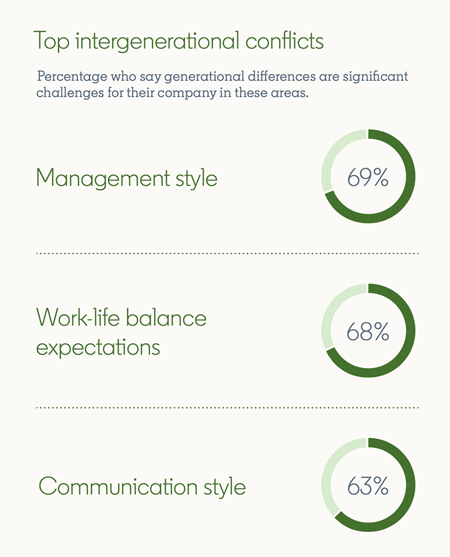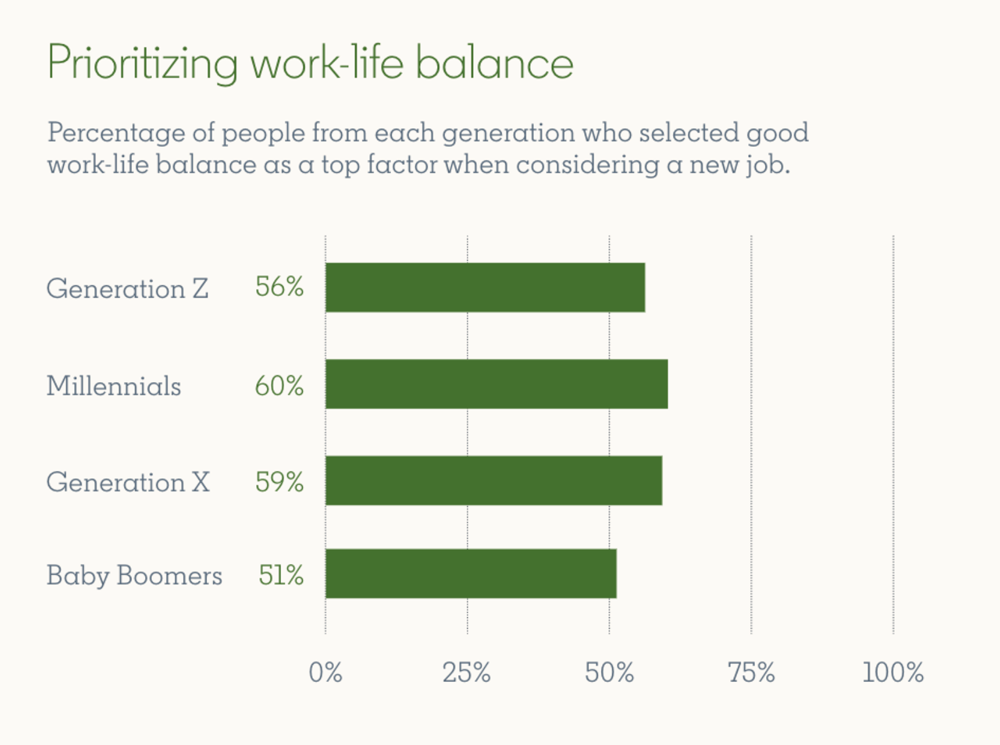The 3 Most Common Reasons Generations Clash at Work
Baby Boomers. Generation X. Millennials. Generation Z. With four generations now making up 98% of the workforce, age diversity is on the rise at companies all around the world.
The Global Talent Trends 2020 report found that 89% of talent professionals view this as a good thing, saying that a multigenerational workforce makes an organization more successful. After all, age diversity allows companies to tap a broader spectrum of perspectives and skillsets, and to be more representative of the population at large. But while generational differences can start the conversation, they can also lead to friction.
Intergenerational conflicts are often exaggerated in the media, but they do exist — and they can hold companies back from reaping the benefits a multigenerational workforce can bring. To help you foster harmony, here are three possible areas of conflict and some strategies to help you avoid them.
1. Management style: Focus on cultivating core leadership traits and setting expectations upfront
Management style was the biggest intergenerational conflict identified by talent professionals in the report, with 69% saying this is a significant challenge for their company.
It’s true that every generation approaches management a little differently and expects different things from their manager. For example, one study found that Gen X’s’ leadership style is characterized by fairness, competence, and straightforwardness, though not necessarily by strong people skills. By contrast, Millennials view strong people skills as the most valuable quality a leader can have. More experienced employees may also be unsure of what to expect from a less experienced manager — and vice versa.
On the surface, it may seem challenging to keep four generations happy at once. But maybe we’re overthinking things.
The truth is, most employees seek more or less the same core traits in a boss — like fairness, empathy, and problem-solving skills. Cultivating these qualities gives managers a strong foundation to stand on when working with employees of all ages.
It’s also important to be as clear as possible when communicating your expectations to your direct reports. This can help you avoid misunderstandings, like an employee making incorrect assumptions based on past experience that differs from your own.
One team member, for example, may have been trained to write reports a certain way, so that’s the way they’ve always done things. If you were trained a little differently, it’s easy to assume that everyone does it the same way you do. Establishing your vision for the task upfront and providing illustrative examples can prevent a lot of frustration for you both, while also opening up a constructive dialogue about alternative ways of working.
As you’re communicating your expectations to employees, don’t be afraid to ask them about their expectations of you, too. Gathering feedback about your management style and how it impacts your reports can help you identify what you need to do to be a more inclusive, supportive manager. It can also give you a sense for any potential conflicts that are starting to rise to the surface, so you can take corrective action.
2. Work-life balance expectations: Be transparent about what your policies are and why
Differing work-life balance expectations present another challenge for employers, with more than two-thirds (68%) of talent professionals agreeing this is a hurdle for their company.
The world of work has evolved a lot in the last 10 years. Once, working evenings, weekends, and holidays was viewed as the mark of a diligent worker. Today, companies are increasingly prioritizing the work-life balance of their employees — ensuring they have plenty of time to recuperate, re-energize, and attend to their personal needs.
This has led to a rise in flexible and remote work options and unlimited vacation policies. The call for a four-day workweek is also gaining steam, with entire countries adding their voices to the mix.
LinkedIn’s survey data revealed that while at least half of the respondents from all generations consider work-life balance to be a top factor when considering a new job, Millennials and Gen X place the most emphasis on it. These generations also value flexible work arrangements the most, with 35% of Millennials and 32% of Gen Xers saying these options are a key consideration, compared to 28% of Baby Boomers and Gen Zers.
While these differences may not seem profound, they can lead to friction. For employees who’ve spent most of their careers working in cultures where longer hours and fewer breaks were tacitly encouraged, new policies may take a little getting used to. And for the generations that grew up in the age of work-life balance, it can be jarring if their expectations don’t match reality when switching jobs.
You can avoid this by being fully transparent about any policies relating to work-life balance — both during the hiring process and with existing employees. Whatever your policies, be sure to explain the rationale behind them clearly. If employees can’t work from home due to security requirements, for example, being candid with them can help you prevent any confusion or resentment.
If you’re struggling to attract Millennial and Gen X talent, you may also want to revisit your flexibility policies to ensure they’re still relevant. The benefits can be far-reaching: after PwC rolled out its culture of flexibility, it found that employees from all generations appreciated having more options — resulting in an increase in engagement.
3. Communication style: Proactively discuss communication preferences to avoid misalignment
Just as expectations about working life have changed over the decades, so too have methods of communication. This has created friction among employees from different generations, with 63% of talent professionals reporting that differing communication styles present a challenge for their company.
One study found that while Baby Boomers and Gen Xers favor in-person communication, Millennials rank email as their top option and Gen Z favor instant chat. If employees aren’t proactive about communication discussing their preferences, this could result in a communication breakdown. For example, research shows that 75% of Millennials avoid phone calls, so managers may want to reserve calling for emergencies only versus general updates.
Expect to encounter a range of communication preferences across every team. Encourage employees to discuss these preferences with their managers and coworkers and trust that they’ll reach a place of compromise and understanding. If an employee knows their manager prefers face-to-face interactions because they consider them more productive, the employee will likely bear this in mind when requesting their help or voicing a concern. And if a manager knows that a remote team member is more likely to see a text when they’re away from their computer, they’ll grab their cell phone if something urgent comes up.
Of course, for larger teams in particular, it might take some time to memorize everyone’s preferences. That’s why some companies even create cheat sheets where team members list the best way to contact them. That way, if a manager or coworker can’t remember someone’s preference in a pinch, they’ve got something to refer to.
We’re more alike than we think we are
While we’re all individuals, we have more in common than we have differences. By building a culture founded on inclusivity, understanding, and mutual respect, you empower every employee to bring their best self to work and to learn from those around them. Age really is just a number — but age diversity benefits everyon
To learn more about managing a multigenerational workforce effectively, download the Global Talent Trends 2020 report today.
To receive blog posts like this one straight in your inbox, subscribe to the blog newsletter.
Topics: Diversity
Related articles





